
“There is nothing new under the sun, but there are new suns.” –Octavia Butler
“There is nothing new under the sun, but there are new suns.” –Octavia Butler

45–50 minute read, or the time it takes to grab lunch.
From their perspectives across disciplines, weaver Marianne Fairbanks and comics artist Anders Nilsen talk through the idea of notation as it relates to their work. As friends and colleagues from their time in Chicago — first as students, then as collaborators — the two artists consider materiality, the process and labor of making, and how far the search for meaning in a work can go.
BY MARIANNE FAIRBANKS AND ANDERS NILSEN
Jessica Ferrer: This first question that we wanted to ask you has to do with your background as co-curators, because for a while you guys were curating at Lula Cafe in Chicago for several years, where you organized a lot of shows. We think that curating is kind of like notation, in a sense where there’s a lot of responsibility in conveying information and value to audiences. So, we were wondering if you could talk a little bit about your approach when you worked on this project and what you were setting out to explore, and how that might have differed from others at the time.
Marianne Fairbanks: Something that is interesting to me about the fact that Anders and I started co-curating is that it was born of the fact that we both worked in this place and loved Lula. Anders was working in the kitchen, and I was working as a waitress. There was a constant presence and a very dynamic energy within the restaurant and the people who were visiting. Our passions for art came through in our desire to put stuff up on the walls that we wanted to see. So that’s how the collaboration started, I think. We spent a lot of our time in that space and we thought we could fill the space with work we wanted to see, and then it continued for thirteen years.
I feel like working with Anders was one of the best collaborations I’ve ever been a part of. And I’m not exactly sure how that happened, but it was probably because we were friends as well, so we liked working together, and it was separate from our own practices as artists. Anders, what do you say about that?
Our ambitions were very small or unassuming. It worked really well, partly because we were friends, but we also had our fingers in different artistic communities, a little bit, and we had different aesthetics, and so we complimented each other really well, I think.
Anders Nilsen: Yeah. I mean, I would say I think that that covers it. We both worked there. We also had just come from the Art Institute, so we were the two resident art people on staff. The position opened up and it was just kind of like, this could be fun. Our ambitions were very small or unassuming. It worked really well, partly because we were friends, but we also had our fingers in different artistic communities, a little bit, and we had different aesthetics, and so we complimented each other really well, I think. There were definitely shows that were super collaborative, but then there were also shows that had, you know, stuff that Marianne would bring in that I would never have come across and probably, you know, the inverse of that.
And then the fact that it lasted for thirteen years, it was just, partially inertia, but I think for me, I don’t know if this is true for you, Marianne, but for me it was sort of nice every few months to take a step away from my own artistic practice and have to be forced to look out in the world and be a fan instead of being obsessed with my own practice, and have this chance to showcase stuff that you felt like the world should see. And then sometimes it was also like, Oh man, the show’s been up for three months. We gotta find something. It was just a scramble to fill the walls.
The one other thing I would say is that, in both coming from the Art Institute — from a little bit of a high art place — it was nice for me to be thinking about putting art on the walls of a place that was very much an everyday sort of place where people weren’t necessarily coming to see art. They were just going to be there, and they were going to encounter this stuff. That was an important part of it for me.
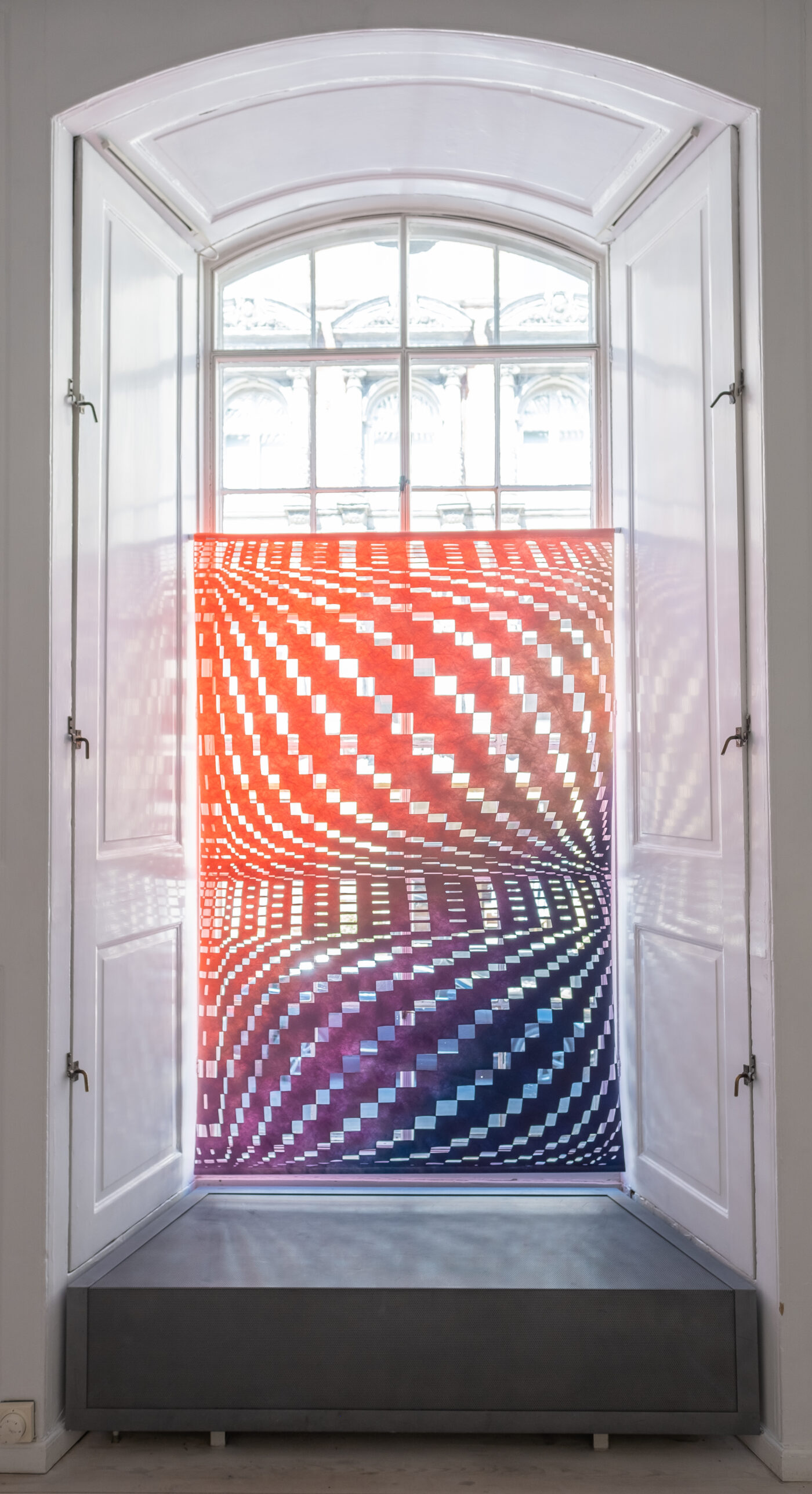
[ID: Photograph of a weaving installed against a window so the light comes through the open spaces and reflects colors on the walls around it. The weaving is red and purple and appears to bulge at the top and the bottom.]
The other story I wanted to tell about our inclinations to even wanting to do it, I think for me, had to do with pushing against painting a bit.
Marianne: Me too. I think that ended up being a huge part of it, for me, because I liked that so many people saw it and that the context wasn’t like, I’m going to a gallery, because we all know that there’s a limited quantity of people who actively make an effort to go to a gallery, but everyone wants to eat some good food. So I liked that subversion of the system, being drawn in by food and then happening to see cool art. I don’t just think theoretically, I think actually the amount of people that saw the work that we curated over the thirteen years is hundreds or thousands of people. Whereas, I know, even from my own experience, walking into a gallery, it never feels quite that busy. I love that we were able to find an audience in a non-traditional art space and get them excited about the work.
And I think we got pretty good feedback, mostly. The other story I wanted to tell about our inclinations to even wanting to do it, I think for me, had to do with pushing against painting a bit. When we took over from the curator who had done it before us, I felt like all the shows were painting because I think that ends up being something that cafes or restaurants can actually show pretty easily. So it’s the default, and so I know that was for me a very strong motivator. When Anders and I had a chance to do our first show, it was a collection show, and we were sort of saying, look, we can show objects, we can show things that aren’t potentially seen as art in a way that feels both fresh and artistic.
Subverting expectations became something that I was really interested in as a curator at Lula. There were many moments within our curation where we were able to experiment and play, whether it was presenting collections of strange objects or inserting one of Claire Ashley’s big inflatable pieces in the corner of the bar. The idea of putting an inflatable sculpture in a restaurant seems insane, but we did it because we really wanted to and we made it work. Those kinds of moments where we were actively pushing against what seemed possible became really pleasurable for me as an artist and a curator.
Anders: And I think those shows often had the most enthusiastic response. Those seemed to be the shows that people remembered, too, the stuff that you wouldn’t see in any restaurant anywhere else in Chicago. Just sort of pushing the boundaries of what was possible. Yeah. That Claire Ashley show was great.
It’s like you were saying, trying to go beyond painting a little bit, but even that first show, which if I remember right, was your idea, the collection show. It’s like going beyond art to, you know, what artists are making — it’s like, what else can we put on display? Museums show art, but there are museums that show objects, almost like anthropology or something, and it’s like, how else does art interact with the world? And not all the collections were artist’s collections, but a lot of them were.
Marianne: Obviously we can go on and on about this, but for me, when you posed the question on email, I was thinking about how at the time, as an artist, I was really engaged in collaborative and community-based making. And I was uninterested in my own work living in a gallery space. That was a moment where the idea of a formal exhibition didn’t entice me very much. But, I really loved curating because it gave me a chance to expose tons of viewers to artists that I was enthusiastic about. It is only more recently that I’ve gotten back to a more solo-based practice that I have realized how much I was able to cultivate my own aesthetic through knowing what I liked to put on the wall and what I wanted other people to see.
I didn’t have the ability to see that in the moment of those thirteen years how much I was learning, but I look back on that experience all the time when I’m installing my own shows and feel grateful to have so much curatorial experience. I have strong feelings about how someone moves through the space and encounters the work. The experience made me more certain of what I want to look at and what I want to make.
Anders: Yeah. I think that’s totally true. It totally made me think about art differently, because in school you’re very much always in this place of critique and what’s working, what’s not working, and you’re sort of trying to figure out what do you respond to? What do you want to do? What kind of art, what kind of artists are you aligning yourself with? And so I feel like I came out of art school with this idea of, “This stuff is valid, and this other stuff is not valid. This is good art, this is bad art,” whatever, whatever. And then being a curator, it sort of forces you to open up a little bit and kind of just be like, this might not fit my theory of art, but it’s super cool, and I want it to go on the wall and I want people to look at it. It sort of forces you to be a little bit less picky, and a little bit more like openhearted and open-minded maybe, which was great. I loved it.
Jessica: That’s great to hear. We had another question that we didn’t end up sending you guys about art versus non-art and you kind of touched on it organically, so that’s great. Just this notion of what gets notated as being art is often painting as Marianne said. Getting folks to think beyond that is super cool and something that I think people are still trying to figure out how to do now.
Anders: Yeah. And I would say, Marianne mentioned coming out of school and being a little bit less interested in the gallery world and doing more socially aware work at that time. I wasn’t going in exactly the same direction, but my choice to move into comics also was very much about moving from a high art space into something that had a more clear connection to a low art space.
Kate Blair: How do you as artists think through the conventions of comics and weaving and how do you interrogate them, if you think you do. And then sort of part two of this is: do you think that comics and textiles speak to each other in any way? Is there any overlapping syntax there?
Anders: Well, the last part of that question brought me back to a show that Marianne curated, uh, when we were both still at the Art Institute. What was it called? Lines?
Marianne: It was In Line.
Anders: In Line, yeah. So you brought in a few people in the Fiber Art department. I don’t know if I was the only drawer…Were there other drawers there?
Marianne: Who was the painter who made that awesome jacket? Oh gosh, I know I’m still following him on Instagram, so I know his name, but he made that jacket. Do you remember, Anders? It was white. And it had these black lines, like he outlined the jacket?
Anders: Oh yeah. Yeah! I know who you’re talking about. Yeah, his stuff was amazing. (Luis Romero)
Marianne: I’m glad you brought up that show. I totally forgot about that.
Anders: But I thought that was cool. I remember you asked me to contribute something to the show and I thought it was a really interesting way of thinking about line because I identified and still identify very much as a drawer. At that point, I was still just barely emerging from being a painter. In undergrad, I had been mostly a painter, and just in the last couple of years previous to that was like, “No, actually I’m a drawer. I like lines.” And so to have you see that and connect it to weaving and fabric and material and stuff, it was great.
Marianne: I was thinking about how Anders and I met in graduate school. Our studios were right next to each other. At that point everything feels new and you have no idea what’s happening, but I remember that Anders was doing the comics. And I remember only then understanding that [comics] perhaps that wasn’t part of what was okay to do in the painting department. [laughter]
It’s a different conversation right now. Now we’re talking about the [Chicago Comics] show that just went up at the MCA, and it seems like comics are fully embraced and have come into their own. But that wasn’t really the case twenty whatever years ago, right, Anders, [when] we were in grad school together?
Anders: Yeah.
Marianne: At that moment, I didn’t quite understand that what Anders was doing was not well-received within the Painting and Drawing department, but now that you’re asking me this question, I was thinking about these forms, whether it’s weaving or comics, as underdogs or as the low art within the “capital-A” art world.
As an undergrad and graduate student, I had studied fibers as an art form, and it’s only now, later in my career, where I’m teaching at a school where I teach weaving within an applied textile design program, that I’m starting to understand a little bit more of the utilitarian and domestic context. I teach in a school that was once the school of home economics and so weaving sat in a position where women were learning the discipline a hundred years ago to create textiles for their homes, whether it was curtains or bed covers or hand towels.
Now it’s called the School of Human Ecology, and it’s much more about human well-being, but we’re still a design department within that context. It’s given me a lot of food for thought in terms of how my practice as a weaver has any relationship with the history of the domestic history of the school. I make weaving for art exhibitions, but recently I have become more interested in the utilitarian and domestic histories of the discipline. The other thing that I think is so cool about weaving is how by intersecting threads at 90 degree angles using intricate binding systems one can produce images, patterns and textile objects, all at the same time!
I love that people have been weaving for thousands of years and somehow they have this ability to understand these complex systems and take advantage of them to make clothing and shelter, both decorative and utilitarian.
In thinking about weaving and comics I don’t think there’s anything inherently similar. But perhaps, if I had to make a connection it is that we are both using lines to make meaning, Anders is using the drawn line to create comics with narratives and I am intersecting threads to create conceptual weavings.
Anders: Yeah, I think there’s — I struggle with the question a little bit too, but I feel like the line is sort of a similarity, if the line is like the thread. I mean I was looking, Marianne, at some of your work in anticipation of this conversation. And some of your window pieces, I mean, any weaving in a way is like hatching, it’s like, you know, the hatching that a lot of cartoonists would do for shading, where the lines are sort of woven together to become a larger structure or whatever. It was fun to see those window pieces in particular. Very cool.
I think I’d seen something on Instagram, but I don’t think I’d fully registered that work. A year and a half ago, I did a piece in a room, like a sort of landscape all around the border of a room on the walls that went onto these large windows. And so those just made me think of that piece of my own, like, playing with the light and lines and what it looks like from both sides and whatever. I dunno, that was neat to see. I like those pieces a lot.
Marianne: Oh, thanks!
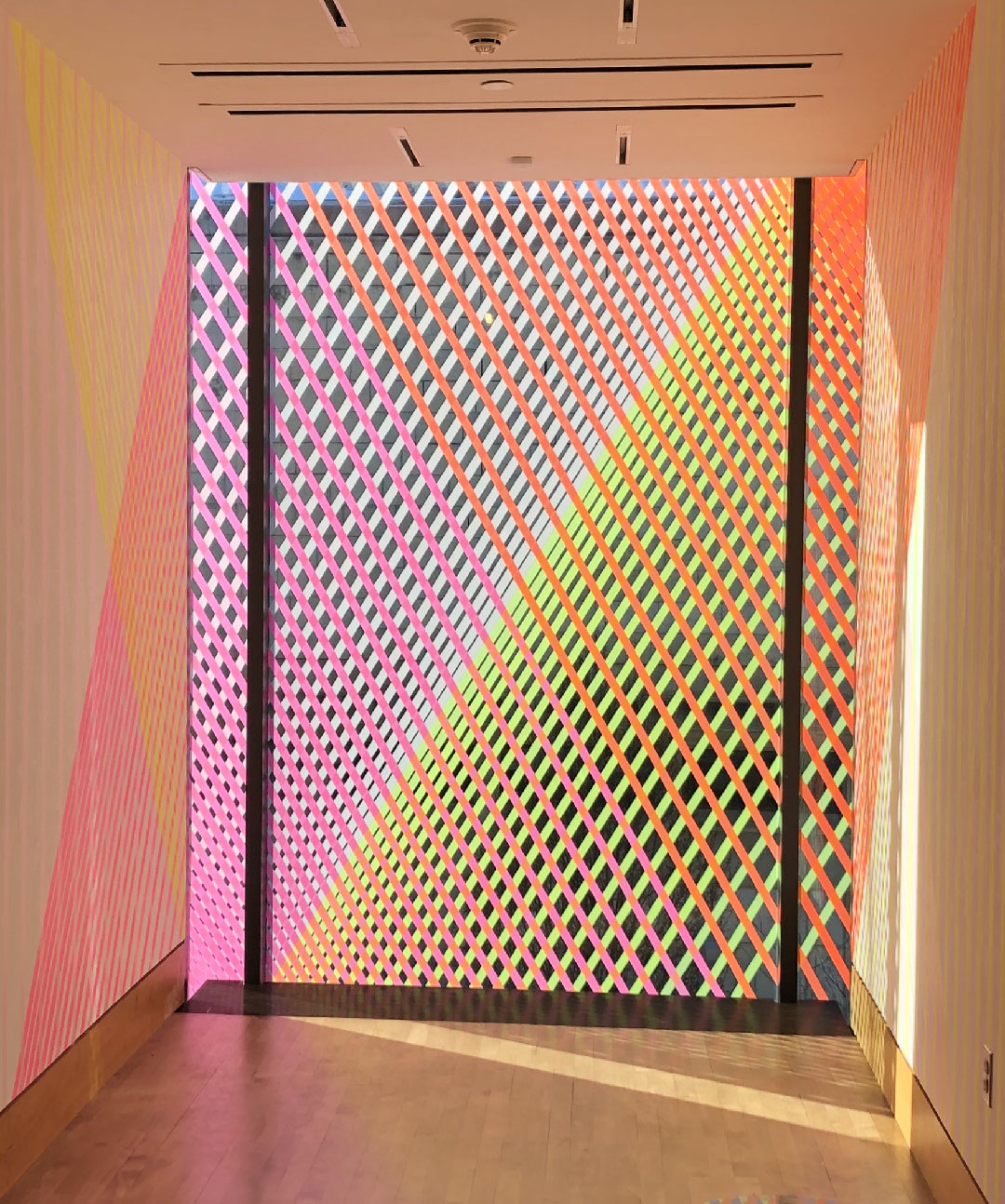
[ID: Photograph of a weaving installed against a large window. Some of the tape extends to the walls. It is composed of yellow, pink, and orange strips of tape woven together to create the effect of two large triangles, one mostly pink, the other mostly yellow. Light filters through to the floor and wall.]
Some artists make work and then spend a lot of time hanging out with each other or whatever. I’m kind of a hermit. I wanna be doing the labor. And there’s another wrinkle to that…
Jessica: As you were talking about these similarities, I also was wondering about how much you think about time with respect to each of your things. Because I think with both of them, there’s a seriality or sequential nature to your practices. Is that something that you’re actively thinking about or is something that just happens as you go along?
Anders: I think so. I mean comics is definitely something that takes a long time. It’s a very labor intensive medium, which is something that is a subject of conversation between cartoonists often. I think it is, at least for me, and I think for a lot of people, it is something that draws you to it probably. I’m somebody who really enjoys just sitting in a room drawing for a long time. [laughter] Some artists make work and then spend a lot of time hanging out with each other or whatever. I’m kind of a hermit. I wanna be doing the labor. And there’s another wrinkle to that, too, which is the way that the contemporary art market works, not that I’m super connected to it, but it works partly on a system of scarcity. If you’re a painter, you can’t flood the market too much. Part of the worth of your work is the fact that it’s hard to come by. I mean, I also know painters who are — if they’re super successful, then there’s enough demand that they’re being run ragged. But I don’t want to do a painting or like twelve paintings in a year and put them on the wall. I want to make a lot, I want to make a 56-page book every year. I want to make 56 little paintings.
Marianne: I don’t know if my first response has anything to do with anything, but it makes me think of your pieces where you get to see some of the process or mistakes. I love the in-progress work where you see the underlines or, when your cat vomited on the drawing and you cut out and then replaced that part. [laughter] Somehow for me, I always love seeing your work where the process and the life stuff kind of meshes into the thing that comes out at the end.
I was also just thinking about time and scale. What you are doing with your line is miniature in a way. You are making things that end up being small and handheld. In the case of weaving, sometimes the small scale of the patterning of the threads can limit the comprehension or the accessibility. Because it’s so complex, these intersections of threads, it’s easy to overlook and not really care about the textile or how it is made.
But going back to these window weavings, one of my main goals with these big lines and bright colors was to create something that could not be overlooked. In terms of strategies and labor and how you get people to see something, for me, I’ve worked so hard to expand into making weaving something that the viewer can appreciate because it is big and bold as opposed to soft and quiet. So anyway, I don’t know if that actually links much, but I was just thinking about scale and how we’re transmitting content to the viewer. As artists, we all have strategies and it’s interesting to hear how Anders’ strategy is production, right? Because if you’re not producing and publishing and distributing you cannot reach your audience. It’s about a multiple. So it’s the opposite of painting, right? Like the more the merrier. So it is sort of production and how many can you do because it’s about generating more narrative and getting it out to a broader audience, which I think is really cool.
Anders: Right. As you were talking about liking the messiness and seeing the process of my pages or my drawings or whatever, it occurred to me that that’s part of the pleasure for me in looking at those window pieces you did. I don’t know if everybody does this, but to me, it’s like, wait, okay, so how did she do it? What piece of tape went down first? Or like, you know, if you’re gonna create that grid, how does it come together? So there’s definitely this thing about inviting somebody into your process. I think a lot of the greatest art allows you to see through the artist’s eyes in a way, or invites you to try to see through their eyes. A lot of my work is intended to be cleaned up and finished, but that process is part of it for me. Some of the work of my own that I feel the closest to, and the most happy with, is the sketchbook work that is all about the process — and hopefully, somebody seeing me being in a moment, drawing a person on a train, and potentially interacting with that person on the train, or [that person gets up] and leaves and then what do I do with the drawing? So yeah, I feel like there’s definitely that commonality.
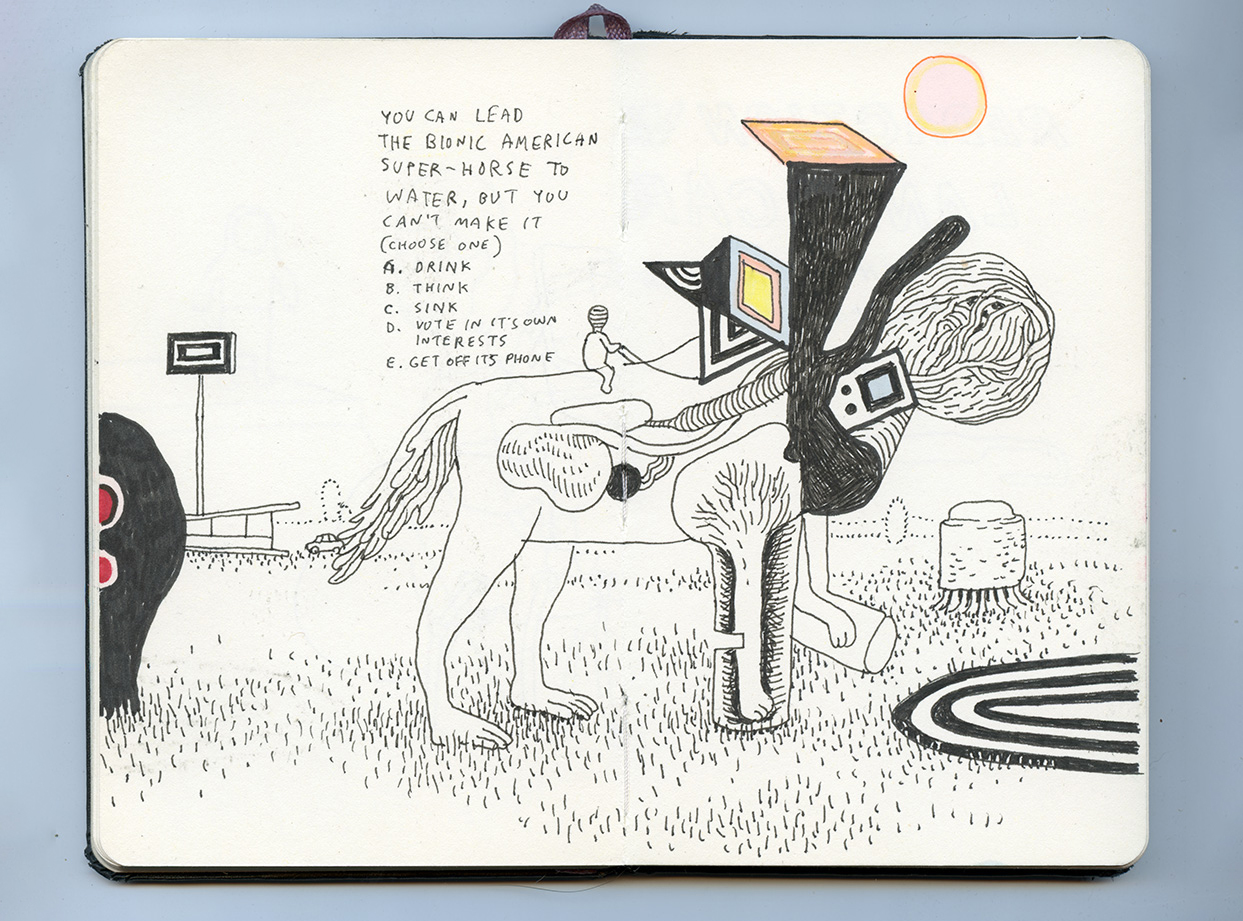
[ID: a photograph of a sketchbook, lying open to a drawing of a small figure riding a surreal animal with four legs. Its back legs have fingers like hands, and its front legs are encased in tubes. Where its head should be is a textured ball that looks like an internal organ. The sketch is mostly black and white with a few splashes of red, yellow, and orange. Text reads above the horse reads “You can lead the bionic American Super-Horse to water, but you can’t make it (choose one) 1. Drink 2. Think 3. Sink 4. Vote in its own interests 5. Get off its phone.”]
Jessica: The next question has to do — similarly to time — but more about both of your interests in physics or mathematics, which are fields that are kind of notorious for notational systems being created and used and argued about. So we were wondering if you could talk about what interests you about them and how those things relate to your practices.
Anders: Marianne, do you have to do math in your head to figure stuff out? I mean, you do sort of — what is it called — do you have to do geometry?
Marianne: There’s a lot of calculating. You’re actually catching me in the moment where I’m teaching beginners how to weave, and there is a lot of math that goes into the planning. For people outside of the craft, it is hard to articulate how much math and engineering go into the process.
Weaving is binary. There’s a warp, the threads stretched in tension on the loop, and a weft, the threads that go back and forth through the warp. Either the warp is up or the weft is up, and that’s it. Somehow it’s this simple and yet the complexity on the other side is so intense because within that system there’s infinite patterning possible. With the infinite potential of intersections add an infinite material choice and infinite colors and textures. This is why there is so much to still explore within weaving.
With the Jacquard loom came the ability to store the weaving patterns in punch cards, one of the first data storage systems. Because we wanted the ability to weave fancy patterns faster, the Jacquard loom was invented to automate part of the process. Like we wanted, not “we” — the French, in particular, wanted it.
Anders: [laughter] Not us, the French wanted it.
Marianne: The French wanted floral patterns in their fabric and they were gonna get it!
Anders: And so, wait, just out of curiosity, when are we talking about?
Marianne: 1805 was when the Jacquard loom came to use in Lyon — I don’t wanna give him all the credit, but the loom is named after him. The punch card loom was something that was coming into fruition from other inventors before he came along, but what he did is he made the automated mechanism that allowed the card to turn to the next one, and the reason that’s important is because the loom went from being a two-person tool to a one-person tool through that automation. So you would step on the treadle and then click, it would go to the next punch card patterning that needed to be lifted to achieve the woven motif.
The punch cards are holding the pattern information and transmitting that to the loom, so either there’s a hole or a solid, and then the wire comes up and either can go through or can’t, and then a warp thread lifts or it doesn’t, and that’s what the Jacquard loom is doing. It was the earliest programmable loom. And so the punch cards were the key to the data storage that led to the modern day computer.
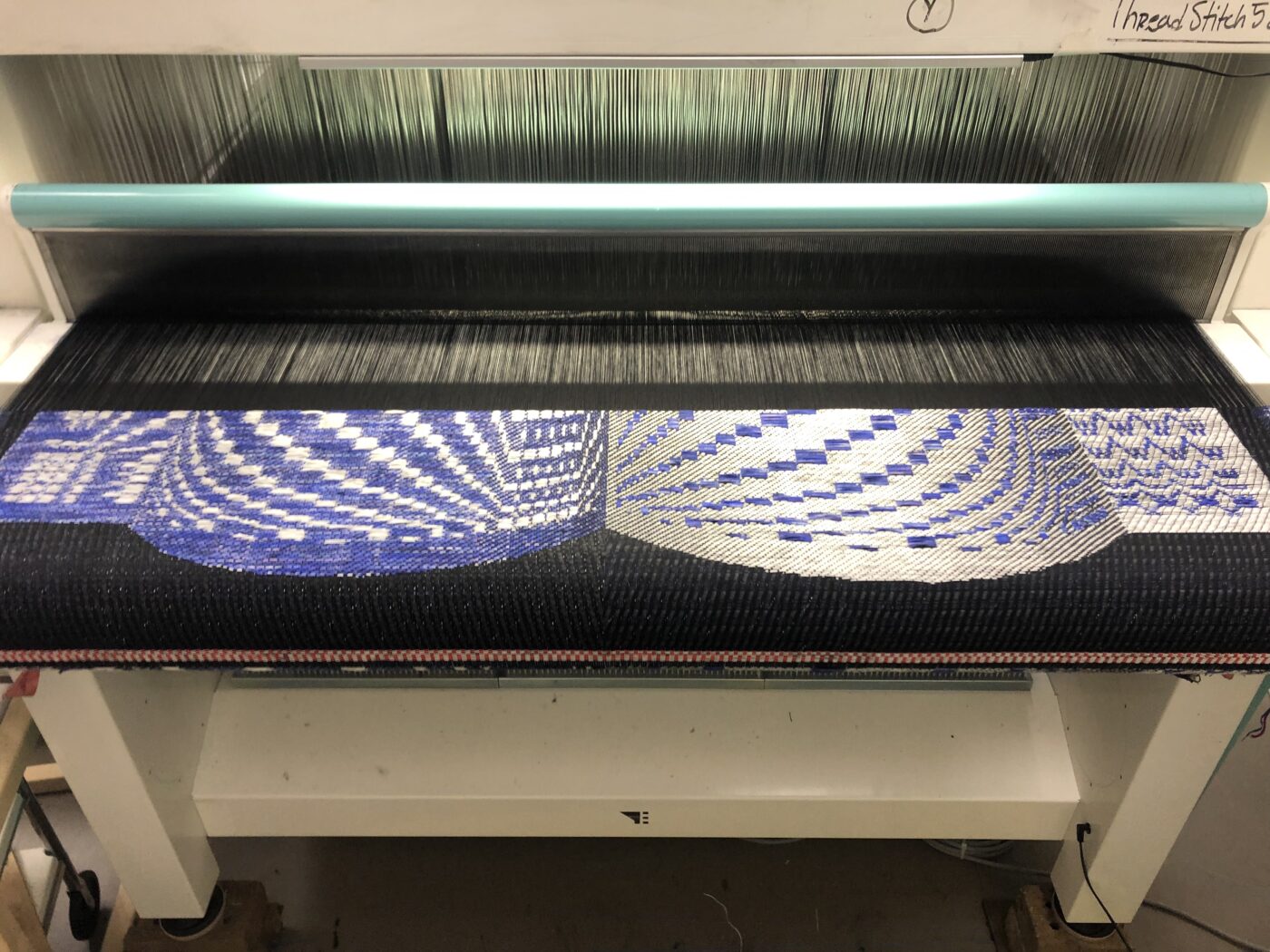
[ID: Overhead shot of a weaving still on the loom. It is half complete with black warp threads still visible at the top.]
The way that I design for a Jacquard loom now is all digital. When the design is complete I can send it to the loom and then the computer is telling the loom what threads to lift but I am still weaving the weft by hand. When designing on the computer the pixel is square, but when translating to the woven cloth the intersection of the different weights of threads doesn’t behave like a pixel so the aspect ratio is often off. Let’s say I’m gonna use a half-inch wide cord versus a silk thread. The way that the fabric then weaves, what I see as a design on my computer screen, is gonna be a hundred percent different depending on the materiality. So, the way that the design or the image expresses itself in real life when you choose a yarn, it’s a really interesting conversion, I think, from a digital pixel-based design to a three-dimensional cloth, if that makes any sense.
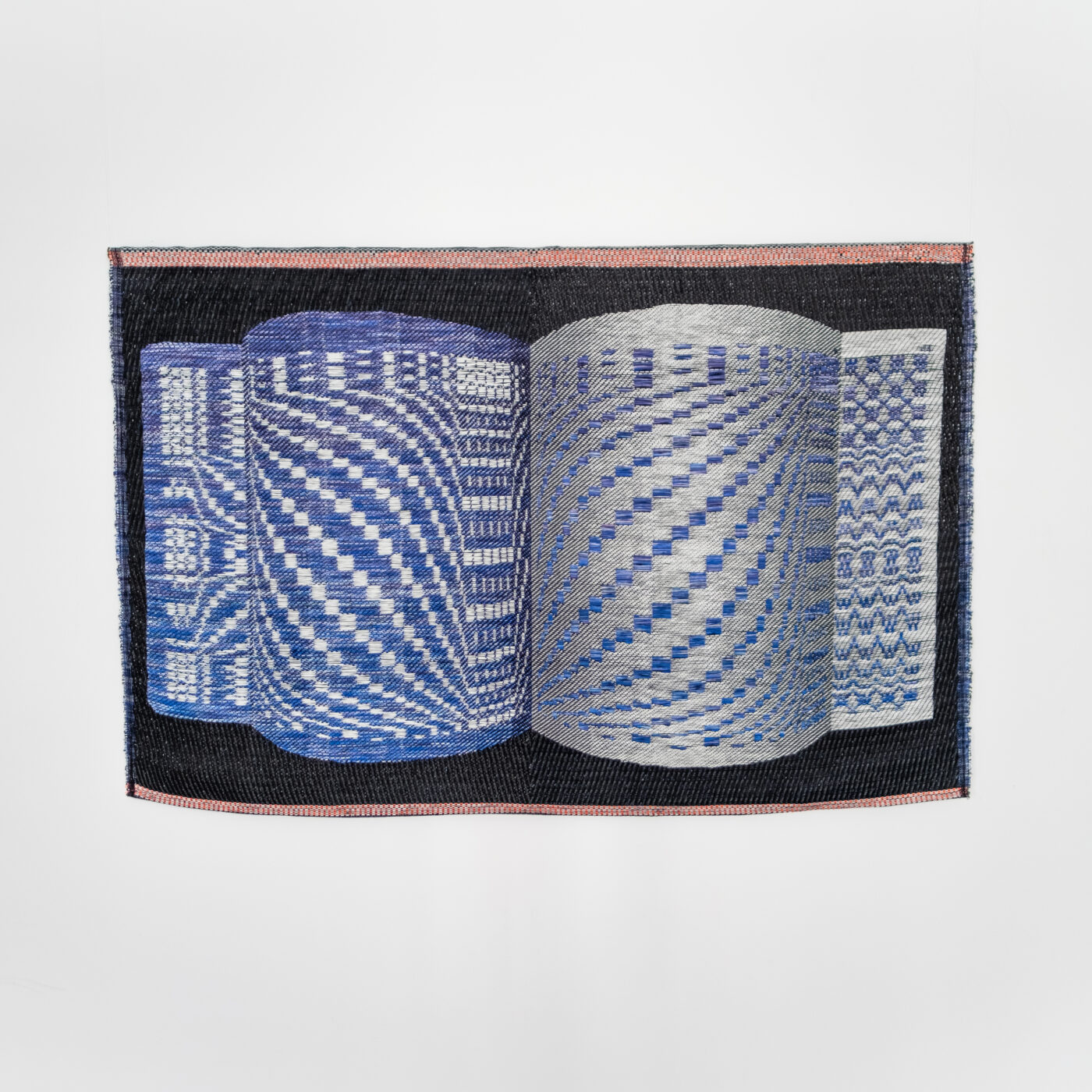
[ID: a weaving of a blue and white object on a black plane, with a design that has a digital feeling, like the inside of a computer. The central image is almost like an open book, with pages that seem to bulge out toward the viewer.]
Anders: I hesitate to go any further down this certain rabbit hole, but do you know what, so Jacquard or whatever, that invention, was it made to create more pictorial weavings?
Marianne: Yes. But in honesty, those weavings were happening before Jacquard came along. Earlier weavers had figured this out. I went to Lyon, France, to do some research into Jacquard at the time that I was learning all of this, and I went to the textile museum there, and they had portraits of people woven well before 1805. Before the Jacquard loom, a second human was on top pulling the threads to create the image. [laughter] So, the same exact results were possible but they could only weave a centimeter a day because of the exacting process of pulling the threads up by hand to create the design.
Anders: Wow.
Marianne: When you’re talking about cross-hatching, Anders, it’s sort of the same way in terms of how you’re representing an image, because let’s say there’s a black warp and a white weft. So just like the two variables, the absence or presence of how many of those are intersecting in a weave structure like a satin can create a gradient that allows you to see an image. Jacquard was weaving, for example, pictures of himself in silk, and it was so fine that people thought it was etched and printed on the cloth, but it was woven into the cloth.
Anders: Part of why I’m asking and I’m interested is because I’ve been listening to this very long, extensive podcast about the French revolution, which starts in 1789 and goes into the 1790s. So the invention of the Jacquard loom was this moment of upheaval or I guess just after a lot of upheaval, but right before a bunch of other upheaval. [laughter]
Marianne: Yeah, I mean, the other thing I learned at that time by going to all the textile museums was that it was really the start of the anarchist worker revolution. It was an early use of the black flag, for example, and the weavers were really pissed because their jobs were being taken away. And so they were actually throwing the looms in the river in Lyon. I remember seeing a black flag in the museum and I can’t remember the French thing, but it was like, “live working or die fighting.”
Anders: Yeah. The parallels with today are striking. Although at the moment we’re not cutting people’s heads off, mostly. [laughter]
Marianne: So the question is how do you think about math and physics? Like how do those things enter your —
Anders: Oh, well, one of the things that made me think of immediately was in Big Questions. In-between chapters, I would do these sort of hyper-ornamental, circular sort of mandala drawings —
Marianne: I remember those.
Anders: — which, in my head, are a little bit like weaving because they’re doing these intersecting lines that create larger patterns. So what I would do is create a sort of circular graph paper and then draw lines intersecting the little lines of the graph paper in a repeating pattern. Before I would start, I would conceptualize, like, oh, I’ll do this kind of line, and then when I’m done, it’ll look super cool. And then I would do it and I would be like, oh, that’s kind of boring actually. There’s a gap between the idea and the execution. I just had that thought of like, it wasn’t exactly math, but yeah, it’s like geometry and trying to figure out how a real pattern manifests versus how you imagine it to manifest. I don’t know if that’s a thing that happens in weaving.
Marianne: Yeah, I think, absolutely. I have a question though, about those, which is, were those a meditative process? Do you zone out or meditate as you’re drawing?
Anders: Yeah. I mean, you could say that. When I think of meditative drawing, I think of stippling grass, like drawing grass for a long time, which is one of the most relaxing, enjoyable things that I do. [laughter] The book I’m working on now is pretty much all in a sort of desert-y place. And so there’s no grass, which is sad. But yeah, no, it’s a very different kind of drawing. You’re not figuring out gesture and how a person is standing and holding their hands and the action of two people interacting. That process was much more like, figure out a process and then just execute it, and see what happens. So there’s a discovery to it, which is nice. And yeah, there is a little bit of a meditative aspect to it.
When I think of meditative drawing, I think of stippling grass, like drawing grass for a long time, which is one of the most relaxing, enjoyable things that I do.
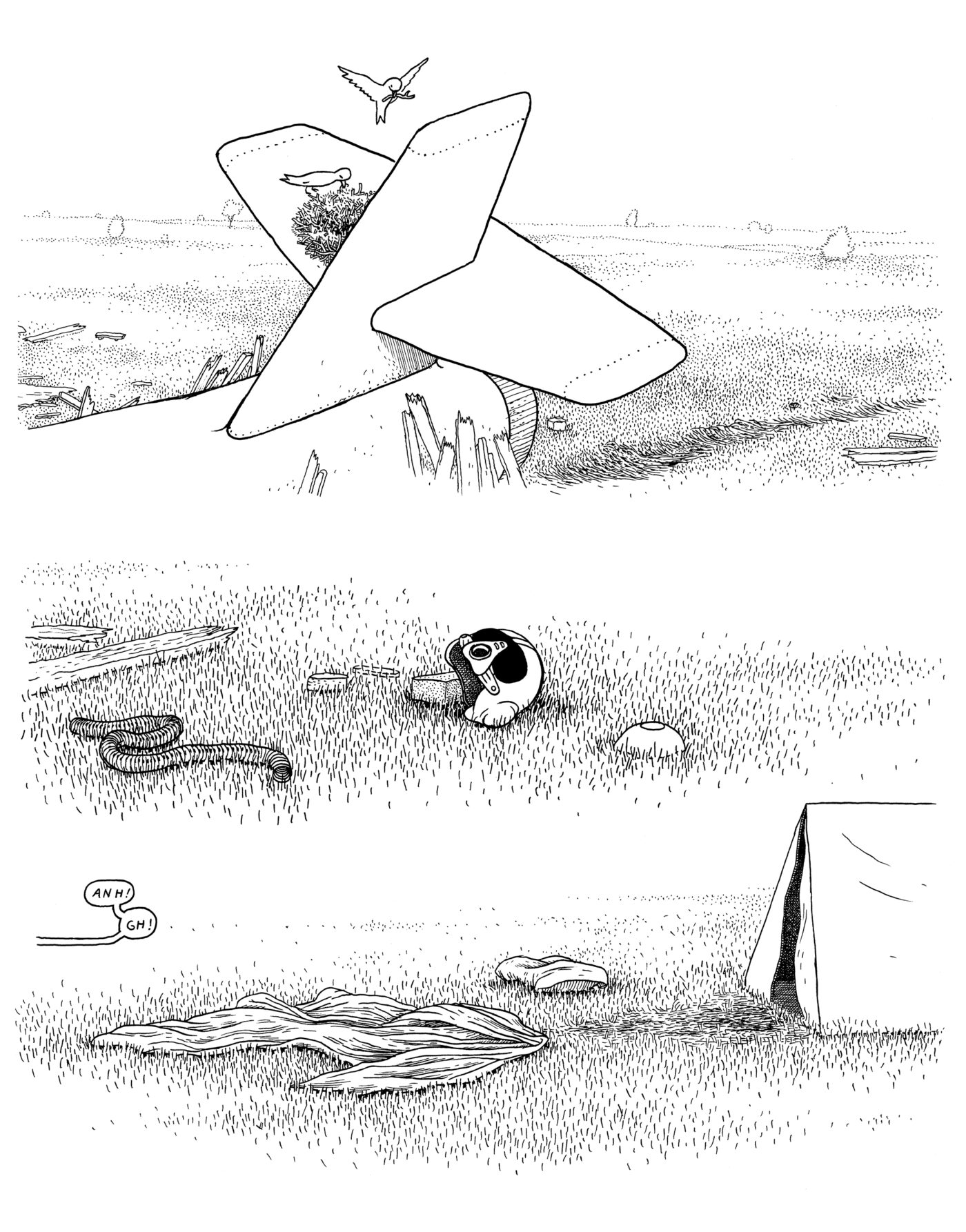
[ID: a full page with three black and white line-drawn comics panels stacked on top of one another, separated only by negative space: birds nesting in a plane propeller, with wreckage from a crash strewn about; a helmet lying on stippled grass, with a bit of tubing and broken beams nearby; a tent, slightly open, with a blanket and pillow thrown outside and speech bubbles from outside the panel reading “ANH! GH!”]
Marianne: To me, that process relates to the inherent math that happens in a maker’s body, where like you said, you had to build a circular graph, and then follow the lines and find the pattern. So it’s not like you’re saying, well, this is a thirty degree angle next to a thirty seven degree angle next to this. And you’re not playing it out from an algorithm or a math-based place, but somehow, physically, you’re accomplishing all of these things that just mean that somehow you know a system. That’s the heart of what I’m talking about with weaving, that somehow you know that this pattern is working or it’s not working because of the way that the threads are intersecting. If you told me the algebraic math principle of the pattern I would have no idea. But that’s what’s so cool about so many art-based practices! The maker knows and is articulating it through their hands.
Anders: It’s like intuitive math or something. Yeah. That just makes me think of a lot of scientists. If you talked to Einstein or Richard Feynman, I mean, they obviously do know the math. They are these insanely incredible mathematicians, but that’s not where the ideas come from. It’s like, they know the math, and then they go for a walk, and it just comes together in their head.
Marianne: Right.
Anders: Which I feel is true. And there’s a kind of math to plot also. The book that I’m working on right now is easily the most complicated plot with the most characters that I’ve ever tried to handle. And it does kind of work like that. You start out with certain things, you have a couple of characters, and you put some sort of obstacles in their path. And then the rest of the story almost kind of just sort of builds itself based on — you know, it’s not exactly that you’re creating a pattern, but if each character story is a thread, you’re sort of plotting and then they intersect in a certain way or they don’t. And it’s like you’re saying with the thread, is it going to be sitting on top or sitting below or can it go through the hole or not go through the hole?
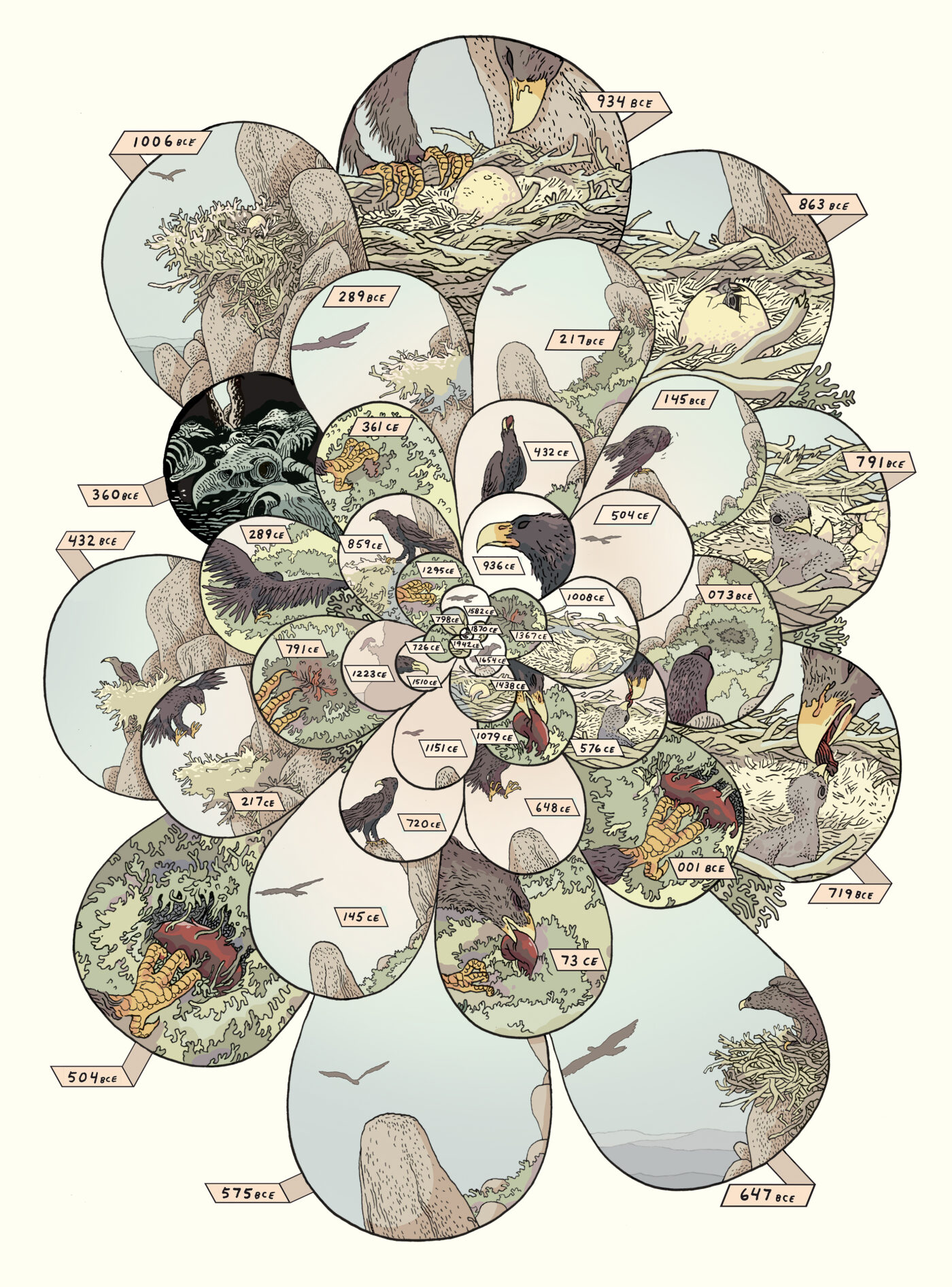
ID: A comics page in muted colors, with the panels laid out in the formation of petals rather than a grid. The petals grow smaller as they move toward the center. Each panel contains a bird — flying, tending to an egg, nesting, a skeleton. Each is labeled with a year, starting with 1006 BCE and moving closer to the present as they reach the center, 1942 CE.]
Kate: That’s a pretty cool segue to the next question that I have. I feel like we’ve kind of been circling it the whole time with some of the earlier questions, but especially since Anders brought up Big Questions. I had a question about the simplicity of a line, I mean, just like basic lines and patterns, which are in weaving and in drawing. How does a line move to evoke these big questions, metaphysical questions, or whatever you’re exploring in your work?
Anders: How does the line itself connect to the questions? I don’t know. I don’t know if it does…
Kate: And that’s totally cool too, if it doesn’t.
Anders: This is where my brain went, anyways — so studying and painting as an undergrad, I felt like painting was sort of about — I feel like I’m going to articulate this and then I’m going to be like, no, that’s not true…but here goes. There was a sense in which it wasn’t about what you painted, you know, this is sort of an early Modernist idea about painting. It’s not about what you’re painting, it’s about how you’re painting it. So like, you know, the Cubists, they were just painting a person like people have been doing for centuries, but they’re putting the nose on the side of the head or whatever, or like Cézanne is doing these little cubes of color with his brushes that’s fracturing the visual field. Or you get the expressionists and it’s big, gloppy blobs of paint, splattered on the canvas.
So it’s not like Francis Bacon was just painting the Pope. People had been painting popes for a thousand years, but he did it in this way that was super weird and horrific. And basically, I think, even in undergrad, I was starting to sort of feel like, well, I don’t want how I paint it to matter. Or like, I don’t want how I draw a thing to be what the art is about. I have these other things that I want to talk about, which are sort of like, the metaphysics or “philosophical” matters of being alive. I want to get the style out of the way. I don’t want people to be thinking about it, about how I draw it. I don’t want the style to draw attention to itself. I want it to just be a vehicle for telling the story. I think that’s probably not really possible because the way you draw inevitably is part of how the reader experiences the work. And the way I draw probably does have some of that, some of my own ideas about the world embedded into it. But that’s the idea. That’s probably a little sideways to the actual question you asked me. What do you think about that, Marianne?
Sometimes I get frustrated because it seems like people are unwilling to spend time with abstract patterns found in weavings. This could be because in this country we don’t have much of a history of weaving compared to some others.
Marianne: I don’t know if this is sideways either, but it’s making me think of what the language of weaving is and the origins. The Stone and the Thread: Andean Roots of Abstract Art is the name of this book that got me thinking about this. It is about the early origins of weaving in pre-Colombian cultures. There are these beautiful abstract patterns, whether its diamonds or the stepped diagonals of a twill that are based in the logic of weaving and seem to be the base vocabulary of all weavers historically and contemporarily. And gratefully this language is embedded in the process of weaving because we cannot look to very old historical textiles for our lessons because they biodegrade and have gone back to the earth. Weaving historically is made out of soft materials that are biodegradable; we don’t have evidence of much of the history woven cloth. They’re inherently impermanent.
We know a little bit about the history because the abstract language of weaving was translated into hard materials, like clay bodies pressed with cord. Lots of cultures did that kind of thing, or the painting of a weaver on a pot. Or the patterns found in a lot of tile work. The patterns of weaving have infiltrated the culture through other media and become more common in what we see while still being blind to the textile origins. Sometimes I get frustrated because it seems like people are unwilling to spend time with abstract patterns found in weavings. This could be because in this country we don’t have much of a history of weaving compared to some others.
I’m thinking a lot about the meaning of pattern and the inherent structures and logic systems that go into cloth and how maybe we’re still trying to learn the potential of its meaning. I am also taken with textiles in their ability as a technology to solve problems. In my own work I am drawn mostly to thinking how, even if it’s just a visual expression, how the patterns can start to tell stories or be the meaningful thing that we’re paying attention to.
Anders: It’s funny, as we’ve been talking, I have this weaving on my wall that I’ve been looking at, which was made by my stepmother’s mother. When I was a kid, she always had a little loom in her living room and she would work on little things. There often would be something in-process. And I always thought it was just like the coolest thing. It was just this amazing object, the loom, and then the idea that she was creating these little pieces of fabric was very evocative as a kid. One year she sent me one, so I have this one that I’m looking at and I’m thinking, okay, it’s very simple colors, lines of grid, and then like, what does it mean?
It made me think about the fact that all these lines are intersecting in complex ways that could never really happen in nature, and that there is this inherent thing about creating order out of chaos. You’re taking these little puff balls on a cotton plant, or shearing your sheep, and first you have to turn it into thread. People have figured out all these ways to take that and make stuff with it. You can go all sorts of different places with that, but I think there’s something about creating that order — it’s like the power of the human mind to create such a simple, orderly, useful thing that we don’t even really pay attention to, but it’s completely impossible without our brains.
Marianne: I guess that’s what I mean, right?
Anders: I mean, there are obviously insects that weave, or create fabric-like things.
Marianne: Weaver birds! That’s the thing. I guess that’s the magic of it. Here’s this thing sitting on your wall that you can appreciate as just something abstract and pictorial but inherent within it is thirty processes, dyeing and spinning and all of the steps that came before it, and then the brain power that got it on the loom and made it into a textile thing. And does any of that even matter? I mean, I guess that’s true of any of our processes.
Anders: Right. The t-shirt I’m wearing is a version of that.
Marianne: I guess that’s the thing. How do we appreciate, and when do we need to appreciate, all the depth of process and brainpower and hands and labor that have gone into any finished thing? I mean, for all of us that’s super complicated. Even for your books, Anders, think about that, right?
Anders: Yeah. At the moment I’m thinking about it a lot, because at the moment, the labor can sometimes feel oppressive. It’s a little too much, but it’s also fun. And I find meaning in it somehow, somewhere.
Marianne: Yeah. Right. I suppose if we still didn’t have questions, going back to the big questions about these bigger life things, we wouldn’t still be making. I could still weave for the rest of my life and know nothing about weaving. I just don’t feel like I’m ever going to know, and so I’m drawn to keep trying. I mean, I could weave all day for the rest of my life and still not know. So that’s sort of where my impetus to keep going is. What else can happen?
Anders: Right. Right. Like seeing that sense of possibility. With comics, for me, that was a huge part of it. I’d been painting and doing installation stuff and whatever. And then I started actually working on comics, taking the little strips that I’d been doing in my sketchbooks and building them, extrapolating on them. And it was just like, wow. Yeah. I could do this forever. Right away I just had that feeling like, oh yeah, this is endless. Sounds like maybe weaving is a little bit like that.
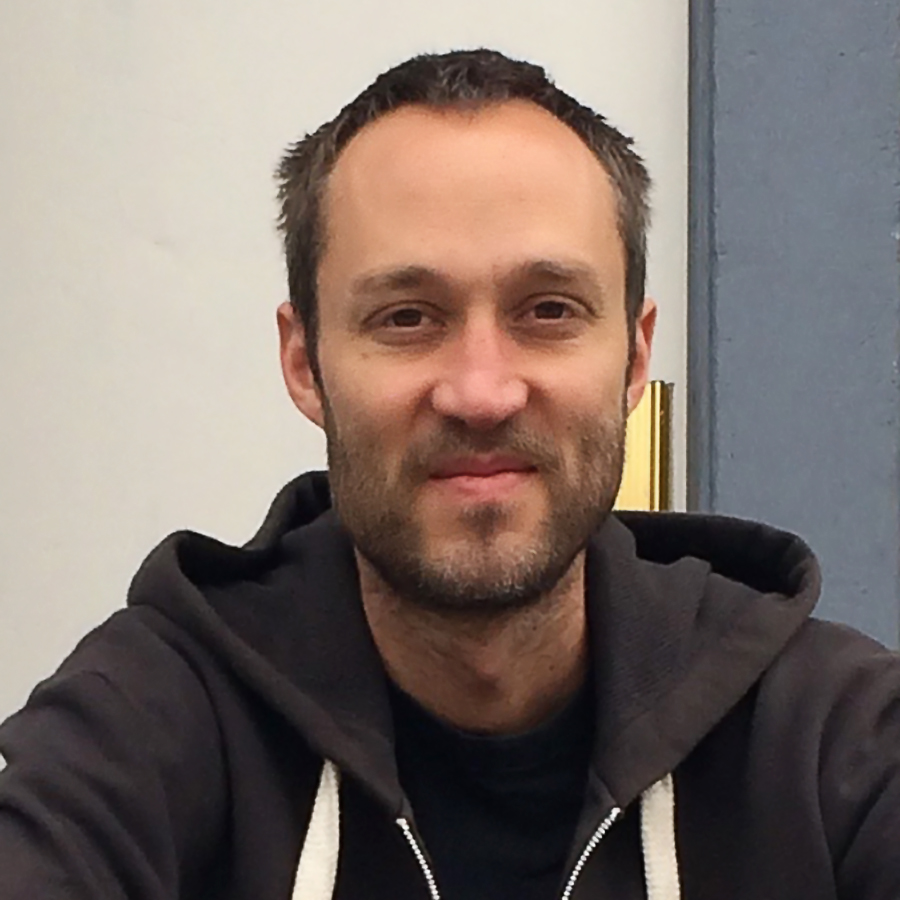
[ID: A slightly scruffy white male in a dark gray hooded sweatshirt squints at the camera.]
Anders Nilsen
He // Him // His
Los Angeles, CA
Anders Nilsen is the author and artist of Big Questions, Don’t Go Where I Can’t Follow, Dogs and Water, and several other graphic novels and books of comics. His work has appeared in Kramer’s Ergot, The New York Times, The Believer, The New Yorker, Poetry Magazine, and elsewhere, and has been translated around the world. He’s currently working on a major graphic novel called Tongues, due out in 2023. He lives in Los Angeles.
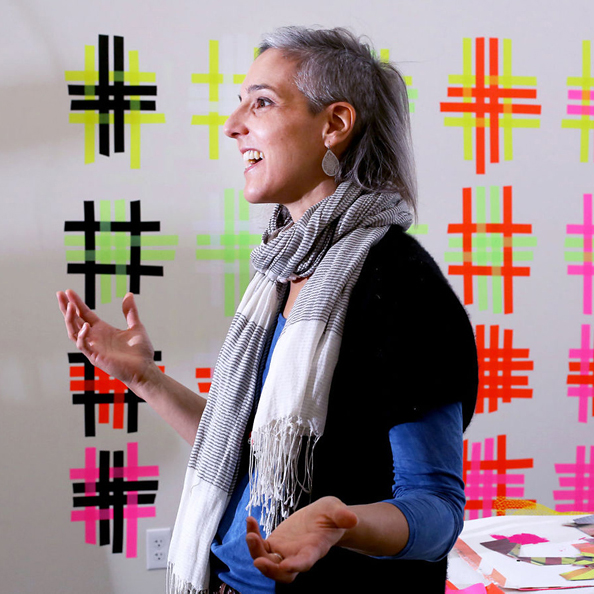
Marianne, a white person with grey hair, in profile against a brightly colored woven wall installation.
Marianne Fairbanks
She // Her // Hers
Madison, WI
Marianne Fairbanks is a 46-year-old white woman who lives in Madison, WI, where she teaches and makes work. She holds two patents and has two kids, two cars, two husbands (just kidding), and one dog. Some strategies she uses in her practices include: making things big, making things bright, and making things bold and graphic. Her hope is that by doing this she can draw the viewer into the work from afar, catch their attention, and get them to move close and investigate the surface.
As a maker, Fairbanks looks to balance high tech methods and processes like jacquard weaving with hands-on messy processes like casting plaster or spray painting. The conceptual goals for the work focus on testing the tensions between pliability and rigidity, micro and macro, material and immaterial.
